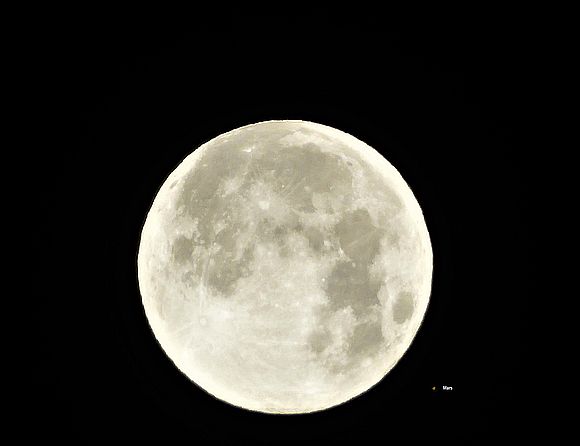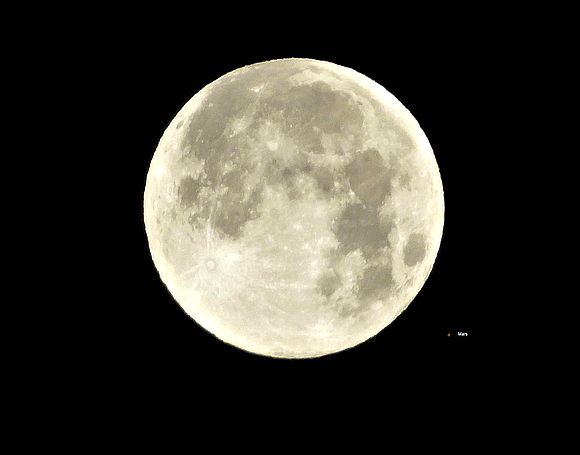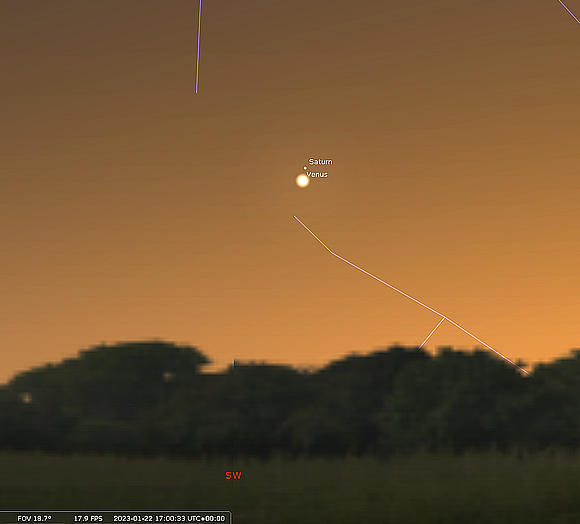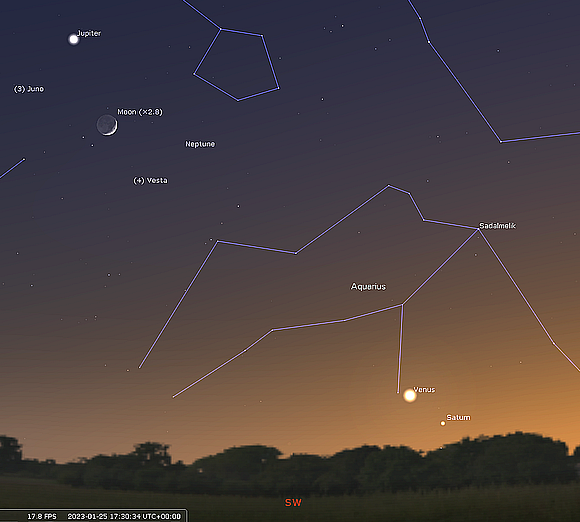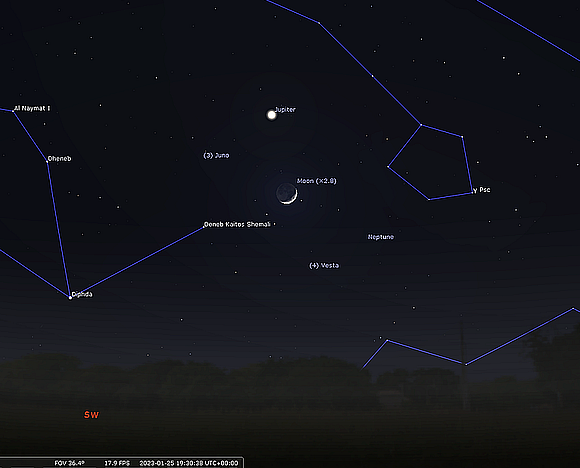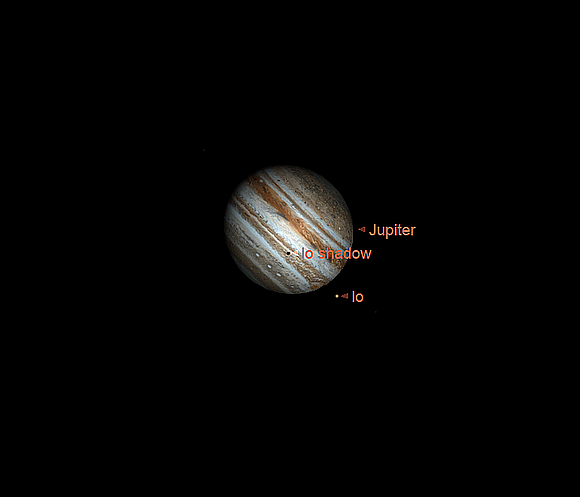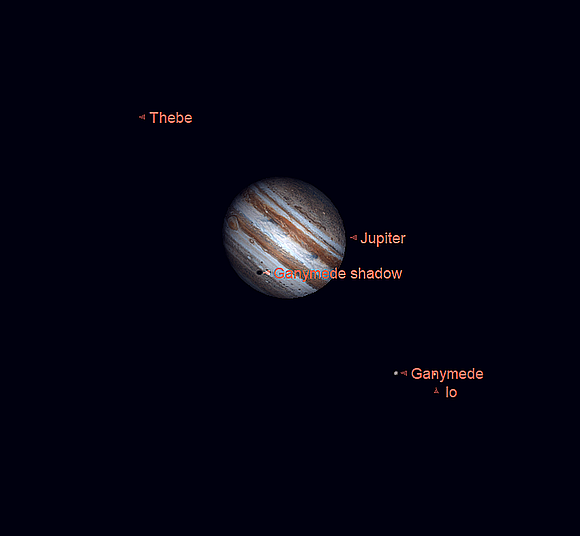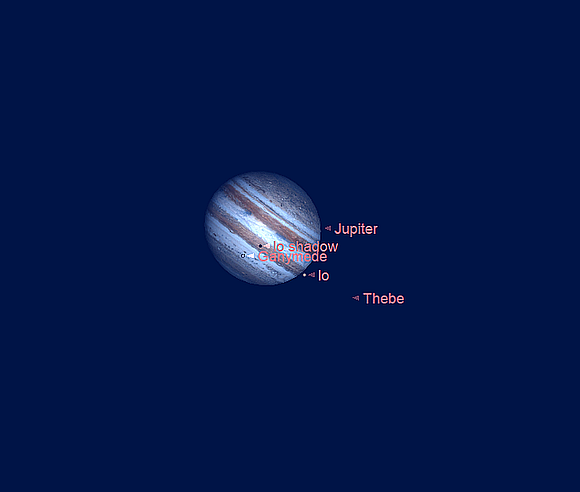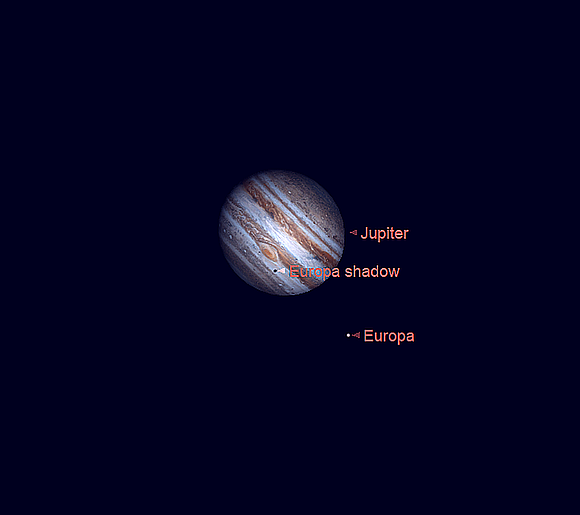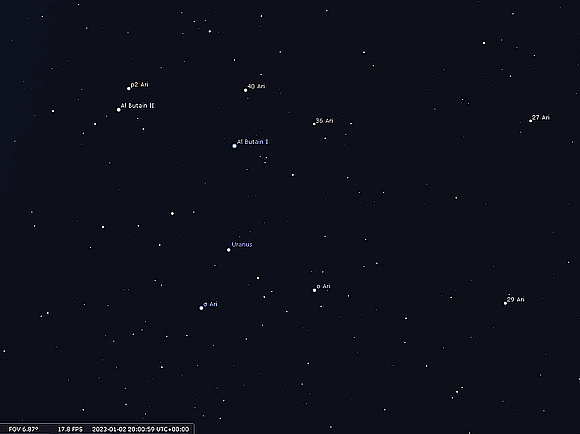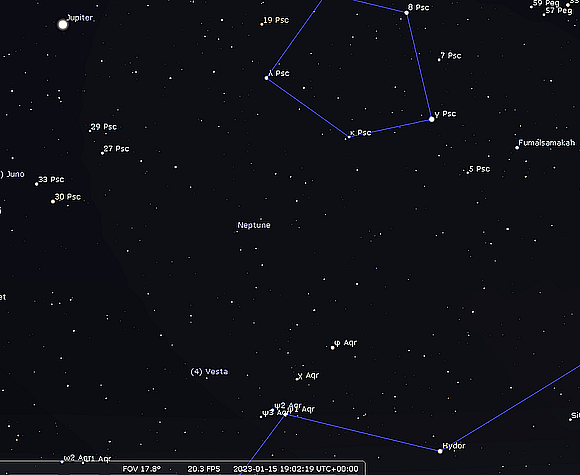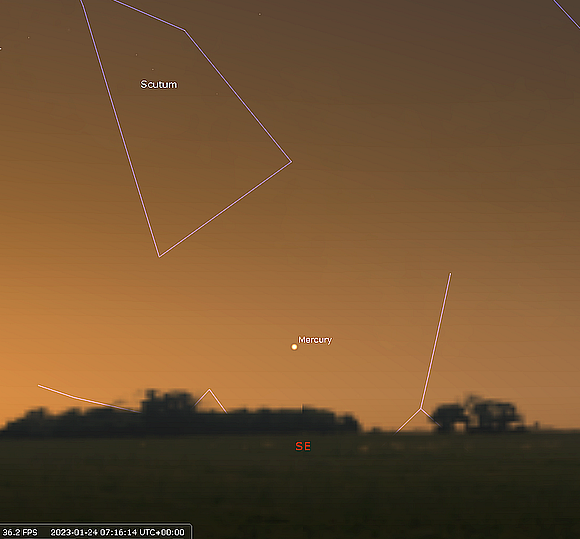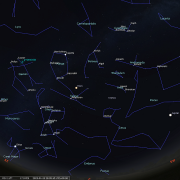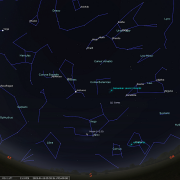In this month's Sky Notes:
Planetary Skylights - Brief
The New Year finds several planets well placed (notably Mars and Jupiter) for observation. Saturn sinks into the twilight meeting Venus as it does so. Mercury may be glimpsed in the evening and dawn sky, whilst Uranus is again occulted by the Moon on the first day of the New Year.
 Mars - the Red Planet remains really well placed in the sky and will be a viable observational target throughout January. At magnitude -1.2 at the start of January, to the naked eye Mars is very conspicuous, an ochre presence located high to the SSE during the evening in the constellation of Taurus, above its chief star Aldebaran (also orange in hue) in the Hyades star cluster. By the month's end Mars will have dimmed to mag - 0.3, which is still far brighter than Aldebaran, so don't get the two confused.
Mars - the Red Planet remains really well placed in the sky and will be a viable observational target throughout January. At magnitude -1.2 at the start of January, to the naked eye Mars is very conspicuous, an ochre presence located high to the SSE during the evening in the constellation of Taurus, above its chief star Aldebaran (also orange in hue) in the Hyades star cluster. By the month's end Mars will have dimmed to mag - 0.3, which is still far brighter than Aldebaran, so don't get the two confused.
Although much higher in the sky, than at recent opposition dates, Mars will still be quite challenging to observe through the eyepiece being only around 75% the size it appeared in 2020. Patience at the eyepiece will be required as seeing varies. As a rough guide, clear skies with twinkling stars usually equates to unsteady seeing. Those nights with perhaps a little haze and steady stars will offer up better views. Magnifications of around 100x will yield an image of Mars similar to how the naked eye perceives a Full Moon. Rule of thumb, use 40X per 25mm of aperture, but only rarely can a magnification in excess of 150x be employed from UK shores. Over the course of January the Martian disk will shrink from 14.5 arc seconds down to 10.7 arc seconds making surface detail more difficult to make out. At least there appear to be no major dust storms on Mars at present. The most prominent surface feature visible will be the wedge or fin shape of Syrtis Major, which shall be apparent on Mars for the first half of January.
The Moon lies immediately below Mars on Jan 3rd and again to the left of it on the 30th making for a pleasing vista. The occultation of Mars by the Moon in the early morning hours of Dec 8th (the date of Mars opposition) coincided with the start of a wintry cold snap in the UK. Ingress was around 04:00hrs with egress around 06:42hrs. Mark missed ingress, his alarm cat (kenny) not waking him up until after 05:00hrs, however he did sort of catch egress, taking a few snapshots from his slightly snowy back garden (it was white over with hail then) They are not brilliant, but at least it's a memento of the event.
Dec 8th - 06:48hrs - Lunar occultation of Mars - shortly after egress.
Image - Mark D (click for full image)
 Venus may be spotted in the January evening twilight sky hugging the SW horizon approximately 30 minutes after sunset. At magnitude -3.9 Venus should be conspicuous enough to cut through the bright twilight before it sets, (around 40 minutes only) so you won’t have too much time. A clear uninterrupted horizon will be needed. Venus will gradually gain in elevation, becoming even more conspicuous as the days, weeks and months tick by, leading to a greatest elongation east of the Sun in early June. During January however Venus gains modestly in altitude, from 5 degrees to 12 degrees above SW horizon.
Venus may be spotted in the January evening twilight sky hugging the SW horizon approximately 30 minutes after sunset. At magnitude -3.9 Venus should be conspicuous enough to cut through the bright twilight before it sets, (around 40 minutes only) so you won’t have too much time. A clear uninterrupted horizon will be needed. Venus will gradually gain in elevation, becoming even more conspicuous as the days, weeks and months tick by, leading to a greatest elongation east of the Sun in early June. During January however Venus gains modestly in altitude, from 5 degrees to 12 degrees above SW horizon.
Over the course of the last week in January Venus encounters Saturn and a crescent Moon (see Saturn) for a fine conjunction. Start viewing from the 20th through until the end of the month at 17:00hrs. Venus will be obvious, with fainter Saturn above (22nd) and then to the side. A slender crescent Moon joins the party on the 23rd making for a pleasing twilight scene.
 Saturn will remain a naked eye object throughout January dropping low into bright twilight, visible for an hour or so. You will locate it low above the SW horizon as dusk falls, although by the end of the month Saturn has set by 17:30hrs. With an apparent magnitude of +0.35 Saturn should be reasonably conspicuous to the naked eye low in the twilight residing amongst the stars of west Capricornus - nearly all of which will be invisible. Should you view Saturn through the eyepiece the image greeting you will be dissapointing - rather unstable, though you may just disern the rings. Before Saturn departs early next month it is involved in one final meeting when it Joins Venus for a close conjunction on January 22nd. They are quite close for a few days either side of this date, affording more opportunity to spot them. A crescent Moon lies off to the left of Saturn and Venus on the 23rd.
Saturn will remain a naked eye object throughout January dropping low into bright twilight, visible for an hour or so. You will locate it low above the SW horizon as dusk falls, although by the end of the month Saturn has set by 17:30hrs. With an apparent magnitude of +0.35 Saturn should be reasonably conspicuous to the naked eye low in the twilight residing amongst the stars of west Capricornus - nearly all of which will be invisible. Should you view Saturn through the eyepiece the image greeting you will be dissapointing - rather unstable, though you may just disern the rings. Before Saturn departs early next month it is involved in one final meeting when it Joins Venus for a close conjunction on January 22nd. They are quite close for a few days either side of this date, affording more opportunity to spot them. A crescent Moon lies off to the left of Saturn and Venus on the 23rd.
 At magnitude -2.2 Jupiter continues to be the most dominant planetary object in the night sky, but is now slipping into the SW region of the sky. At the start of the month Jupiter will still be well placed for UK observers, located quite high to the SW as dusk gathers. By the end of the month it is setting by 21:00hrs. A slim crescent Moon shines below Jupiter on Jan 25th - early evening.
At magnitude -2.2 Jupiter continues to be the most dominant planetary object in the night sky, but is now slipping into the SW region of the sky. At the start of the month Jupiter will still be well placed for UK observers, located quite high to the SW as dusk gathers. By the end of the month it is setting by 21:00hrs. A slim crescent Moon shines below Jupiter on Jan 25th - early evening.
Through the eyepiece Jupiter is a fine sight, the oblate disk appearing an impressive 45 arc seconds in diameter and fascinating to study. Observers should note changes to disk features, including the banding and GRS (Great Red Spot). The Great Red Spot (GRS) is a colossal storm system, which over the last few decades appears to have diminished in size and hue intensity and is now carefully monitored by astronomers. It is visible in apertures of 100mm (4") and above.
Jupiter is flanked by the Galilean moons, seen as specks of light close by, but planetary sized worlds in their own right. Regular observers of the Jovian system will note the 'dance' of Io, Europa, Ganymede and Callisto around Jupiter, throwing up a different configuration each night, with shadow transits particularly fascinating to follow. If you have a 4" (100mm) aperture scope and above, shadow transits of moons passing on the near side of Jupiter will be visible, jet black dots of varying size dependant on which moon is involved.
The moons themselves are more difficult to spot as they pass in front of Jupiter, requiring larger apertures. The most favourable evening shadow transits this month are Io -Jan 4th @ 19:00hrs, Jan 20th @ 17:15hrs & Jan 27th @ 17:00hrs. Ganymede - Jan 13th @ 18:00hrs. Europa - Jan 23rd @ 18:00hrs.
 Uranus remains well placed for observation in the evening sky located in the lower reaches of Aries. Culminating over 50 degrees above the south horizon by 21:00hrs and is thus well above horizon murk and turbulent air. At magnitude +5.7, the planet is technically visible to the naked eye, but dark, transparent skies are required to achieve this. Uranus can be spotted as a star-like object through binoculars, but the miniscule disk; ghoulish grey/green in hue and just 3.6 arc seconds in diameter, is revealed only in telescopes of apertures 75mm (3") and greater at medium magnification.
Uranus remains well placed for observation in the evening sky located in the lower reaches of Aries. Culminating over 50 degrees above the south horizon by 21:00hrs and is thus well above horizon murk and turbulent air. At magnitude +5.7, the planet is technically visible to the naked eye, but dark, transparent skies are required to achieve this. Uranus can be spotted as a star-like object through binoculars, but the miniscule disk; ghoulish grey/green in hue and just 3.6 arc seconds in diameter, is revealed only in telescopes of apertures 75mm (3") and greater at medium magnification.
Perhaps the most difficult aspect of locating Uranus is indentifying the general area of sky in which it currently resides, a 'no man's land' devoid of apparent naked eye stars below Aries, west of Taurus and to the east of Cetus and Pisces. The nearest 'bright' apparent naked eye star is sigma Ari at magnitude +4.35, which sits 1.5 degrees upper left of Uranus. Over the course of a month you will notice the movement of Uranus in comparison to background stars. On Jan 1st Uranus is occulted by the gibbous Moon. Unlike the very early evening occultation of Uranus last month, this one occurs late evening and into the following morning. Ingress of Uranus is around 21:00hrs UT on the 1st from Whitby, with egress not occurring until 00:20hrs on the 2nd, making it around six times the duration of the occultation in December. If you missed the last event, this is a yet another great opportunity to track down the distant 2.8 billion km world!
 Remote Neptune is quite well placed for observation in the evening sky residing amongst the stars of northern Aquarius, some 6 degrees lower right of Jupiter. At a distance of 4.32 billion Km, Neptune appears a feeble magnitude +7.8 object, visible in binoculars as a speck only, a telescope with an aperture of at least 100mm (4") + is required to reveal its tiny blue/grey disk barely 2.5 arc seconds in diameter. Although Neptune resides just within the borders of Aquarius, the closest visible star is the mag +5.5 star 20 Piscium (HIP 117375) with 96 Aqr almost the same distance to the SW of Neptune. By the month’s end Neptune is setting by 21:30hrs.
Remote Neptune is quite well placed for observation in the evening sky residing amongst the stars of northern Aquarius, some 6 degrees lower right of Jupiter. At a distance of 4.32 billion Km, Neptune appears a feeble magnitude +7.8 object, visible in binoculars as a speck only, a telescope with an aperture of at least 100mm (4") + is required to reveal its tiny blue/grey disk barely 2.5 arc seconds in diameter. Although Neptune resides just within the borders of Aquarius, the closest visible star is the mag +5.5 star 20 Piscium (HIP 117375) with 96 Aqr almost the same distance to the SW of Neptune. By the month’s end Neptune is setting by 21:30hrs.
 Mercury may be glimpsed in both the January evening and dawn sky, although to spot it at the beginning of January in the evening twilight sky will be challenging. To do so, view to the SW over the first few days of the New Year around 16:00-16:15hrs. You should spot brilliant Venus easily enough, Mercury though will be trickier, sitting around 5 degrees (roughly a binocular field) to the right of Venus and slightly lower. They will be just 5 degrees above the SW horizon. At magnitude +1.58 you will in all probability require binoculars to accomplish the task of spotting Mercury in the bright twilight. Mercury will then depart the sky, the elusive messenger reappearing after mid-month in the dawn sky.
Mercury may be glimpsed in both the January evening and dawn sky, although to spot it at the beginning of January in the evening twilight sky will be challenging. To do so, view to the SW over the first few days of the New Year around 16:00-16:15hrs. You should spot brilliant Venus easily enough, Mercury though will be trickier, sitting around 5 degrees (roughly a binocular field) to the right of Venus and slightly lower. They will be just 5 degrees above the SW horizon. At magnitude +1.58 you will in all probability require binoculars to accomplish the task of spotting Mercury in the bright twilight. Mercury will then depart the sky, the elusive messenger reappearing after mid-month in the dawn sky.
Look for it then during the final week of the month a few degrees above the SE horizon around 07:15hrs. Mercury will then be a negative magnitude object (around -0.2), considerably easier to spot with binoculars and should be visible to the naked eye.
January Meteor and Comet Activity
The start of the New Year brings with it one of the top three meteor showers - the Quadrantids, with a ZHR peak rate topping 100. They are named for the now defunct constellation of Quadrans Muralis, which was removed from sky charts in 1922, but used to lie at the junction between Hercules, Bootes and Ursa Major. The Quadrantids are the least observed of the 'big three' meteor showers, factors such as timing, weather and most of all a short peak duration of just a few hours at play here. The Quadrantids are active from Jan 1st - Jan 6th, with the peak occurring this year around 04:00hrs GMT on January 4th - just a few hours in duration. Unfortunately a 92% gibbous Moon will be present in the sky drowning out the majority of meteors likely to be visible, but don't despair completely.
During the evening the shower radiant is positioned low to the N, but by early dawn is better placed some 50 degrees above the SE horizon. By 04:00hrs the Moon will then be less than 20 degrees above the horizon, and if shielded in some fashion will allow an observer a pretty decent chance of spotting quite a few meteors, Quadrantids often being quite bright. Don't expect to see anything like 100, but if conditions are clear expect to witness a respectable 15-30 per hour. One convenient thing about meteor observing is that you do not require any additional optical assistance; the naked eye is quite sufficient, just wrap up warmly and good hunting.
Comet 2022 E3 (ZTF) may become a borderline naked eye comet at the end of January, but should be an easy binocular object at very least. Discovered in March by the Zwicky Transient Facility, the comet is, as of writing, slightly brighter than predictions, around mag +10.2 (late December) reaching perihelion on Jan 17th when 1.11AU from the Sun and could be around +6.5 in magnitude. At the start of the month comet E3 is located in Corona Borealis, which rises around midnight from the UK and will lie over 30 degrees in elevation by 04:00hrs. By mid-month comet E3 continues to head north in the sky, passing into north-eastern Bootes, picking up speed as it does so, travelling 3.4 arc seconds per minute. Observing opportunities are further enhanced as by January 21st the Moon will be New as comet E3 continues to head north - passing through Draco, Ursa Major and at the end of the month when near closest approach, Camelopardalis, by which time it is hurtling along at 17 arc seconds per minute, readily noticeable in binoculars and may sport a noticeable tail.
For accurate and up to date charts of comets please visit https://theskylive.com.
January Night Sky
As darkness descends the southern and western aspect of the night sky is still dominated by autumnal constellations and even a number of circumpolar summer groups. The great square of Pegasus occupies much of the higher regions of the SSW, below which reside the less conspicuous constellations of Pisces and Aquarius. Cetus the whale continues to churn along the South horizon below Pisces; slipping below the horizon by midnight later in the month. Use the front two stars in the square to locate the 'Krakens' brightest star Diphda.
We may be in the midst of Winter, but much of the western aspect during early evening offers up more of a 'summer' vibe with a number of constellations associated with July and August skies still well placed. Notable amongst these is Cygnus, the stars of which hang in crucifix form below its chief star Deneb above the WNW horizon. Below Deneb in the NW sparkling steely blue Vega, the most conspicuous of the summer triangle stars, catches the eye in Lyra. The third member of the summer trio; Altair in Aquila, sets by 18:00hrs, but is visible throughout January until at least then. As the night and month wears on, Deneb and Vega will slide down into the North, but remain visible, being circumpolar.
Viewing to the North during the evening note the familiar ‘saucepan’ asterism of the Plough, part of Ursa Major. Directly above the Plough sits Ursa Minor in which the Pole star, Polaris resides (use the pointer stars in the bowl of the Plough -Dubhe and Merak to locate it). The Celestial dragon – Draco winds its way between the two bears towards the NNW where the head of the beast is marked by an irregular quadrilateral of stars not far from Vega.
Overhead the distinctive ‘W’ pattern of Queen Cassiopeia first occupies the zenith, followed later by Perseus (the outline of which resemble a distorted figure Pi symbol) and then the stars of Auriga the charioteer, highlighted by brilliant Capella, which lies just shy of the zenith by 22:00hrs. The faint stars of Lynx slink after the charioteer.
It is to the South and East where the observer is treated to an array of imposing constellations and brilliant stars, rich in mythology and observational interest. Leading this wondrous stellar cavalcade are the stars associated with Taurus the Bull, which include the two open star clusters, the Pleiades and the Hyades. Prominent ruddy Aldebaran - “the eye of the bull’ is the most conspicuous presence in the Hyades, a ‘V’ or arrowhead arrangement of stars, though it is not a genuine member, lying at half the distance of true member stars. Brilliant Mars currently resides in Taurus not far from Aldebaran and is of a similar hue. Further west of the Hyades, the Pleiades star cluster (Seven Sisters) is truly a beautiful sight in binoculars or low power eyepiece. It is one of the most youthful clusters by stellar standards. Keen sighted observers can make out more than seven stars with the naked eye, although most people see five or six. Binoculars, or very low telescopic magnifications reveal dozens of stars and the entire cluster contains over 300 members approximately 400 light years away.
By late evening, or viewed later in the month, the constellation of Orion - the mighty hunter, stands proud at the heart of this glittering tableau ranged across the southern aspect. The main outline of the hunter is quite distinct; three stars in a sloping line set in the midst of a larger rectangle bounded by 4 others. Two of these stars, in opposing corners are real super luminaries’. Rigel illuminates the bottom right of the rectangle, a B7 class blue/white star upwards of 60 thousand times more luminous than our Sun. The top left corner is marked by the deep orange hue of Betelgeuse, a red super-giant star already ballooned to gargantuan proportions, over 400 million miles in diameter and with one foot in the stellar grave. Betelgeuse is probably the strongest candidate of a star to go supernova we know of, perhaps within the next 10-20 thousand years, the recent temporary fading of this star, maybe an indication of initial behaviour towards this cataclysmic fate. Rigel is also massive enough to end its days as a supernova, tens of millions years in the future, short by stellar standards.
Situated beneath the three stars marking Orion’s belt is one of the great show piece objects in the night sky, the Orion nebula, the closest region of stellar birth to us at around 1300 light years. The Nebula consists of a huge cloud of gas and dust in which new stars are “born”. Seen clearly as a misty smudge through binoculars, telescopically the nebula can be quite breathtaking in the right instrument, a swirl of nebulous cloud at the heart of which reside a trapezoid-shaped asterism from which the cluster gets its name, the Trapezium, the four “bully boys” of this stellar crèche. The brightest members are found within 1.5 light years of each other and have estimated solar masses of between 15 and 30 times our Sun. These young OB stars are luminous X-ray sources and are also responsible for much of the illumination of the surrounding nebula. It is thought the Trapezium stars are little more than 300,000 years old. The stars are easily seen through the eyepiece of most telescopes.
Upper left of Orion stand the Twins of Gemini, marked by the two conspicuous stars, Castor and Pollux. Castor, the most northerly of the pair, is slightly fainter than twin brother Pollux which shines with a pale amber lustre. Although Castor appears solitary, in reality it is a multiple system of which the brightest two components may be separated in a modest scope, given stable atmospheric conditions.
The two hunting dogs of Orion, Canis Major and Canis Minor, dutifully follow their master across the heavens. The belt stars of Orion point down in the general direction of Canis Major and the most prominent of all night stars, sparkling Sirius, its chief star, seen low to the SE. Some distance above and left, solitary Procyon, in the lesser dog of Canis Minor, is yet another highly conspicuous winter jewel, the prominence of both stars primarily due to proximity; 8.6 and 11 light years respectively.
The dog’s quarry, the timid celestial hare of Lepus, may be traced crouching below Orion and above the southern horizon. Look for the he faint glow of the winter Milky Way which passes down to the left of Orion, separating the two dogs on opposing banks. A few of the faint stars set amidst this milky haze comprise the heavenly unicorn of Monocerus. Yet another watery course meandering in this part of the sky rises next to Rigel in Orion. The dim stars of the river Eridanus first flow parallel with the southern horizon before looping back and then plunging through it, journeying far down into the southern hemisphere before ending at a brilliant star called Archenar. Not surprisingly Eridanus is the longest (though not largest by area) constellation in the entire heavens.
Finally, by the month’s end the first celestial shoots of Spring are already sprouting from the eastern horizon making inroads well into the late evening sky. The faint stars of Cancer scuttle after Gemini and mark the border of seasonal change from Winter to Spring. Leo the lion follows, identified by the ‘Sickle’ asterism at the foot of which shines bright Regulus. The faint, but distinctive head of Hydra sits below Procyon, the rest of the snake gradually slithering above the horizon, but not doing so entirely until after midnight. Chose your instrument; binoculars, telescope or even the naked eye, wrap up well and enjoy the free vista.
January 2023 Sky Charts
Additional Image Credits:
- Planets and Comets where not otherwise mentioned: NASA
- Sky Charts: Stellarium Software and Starry Night Pro Plus 8
- Log in to post comments




